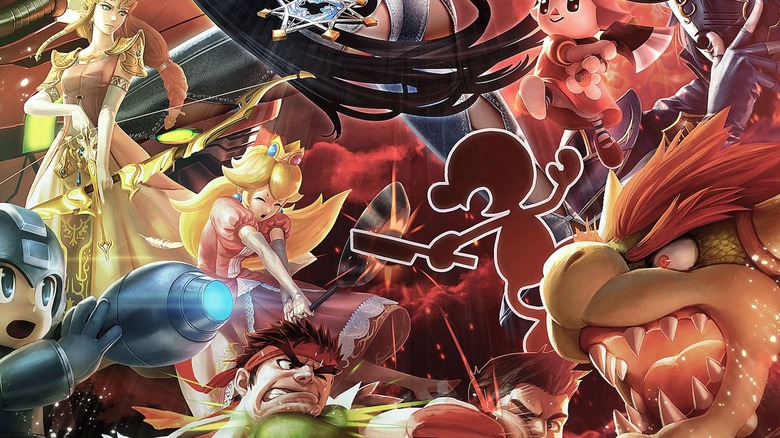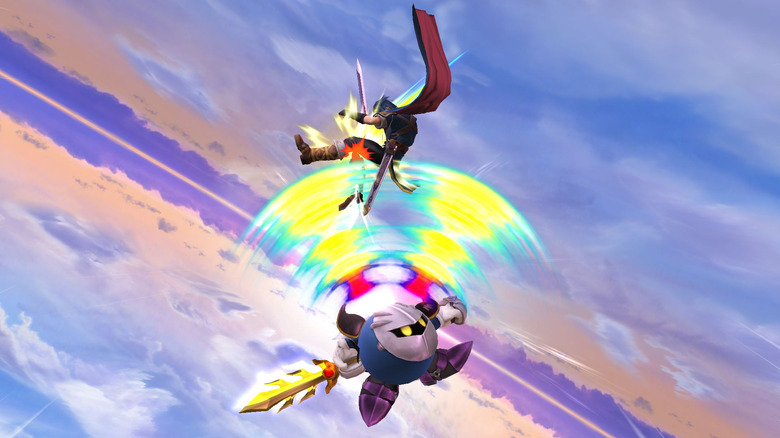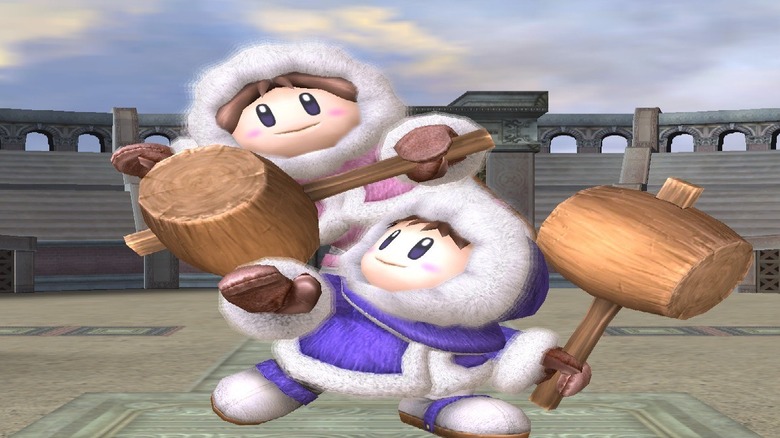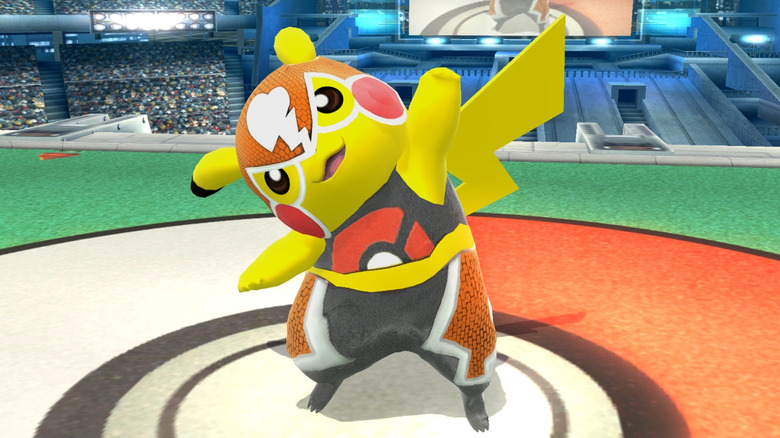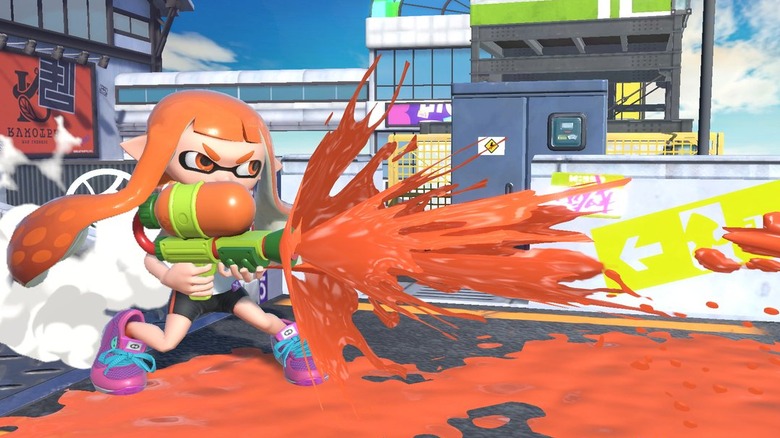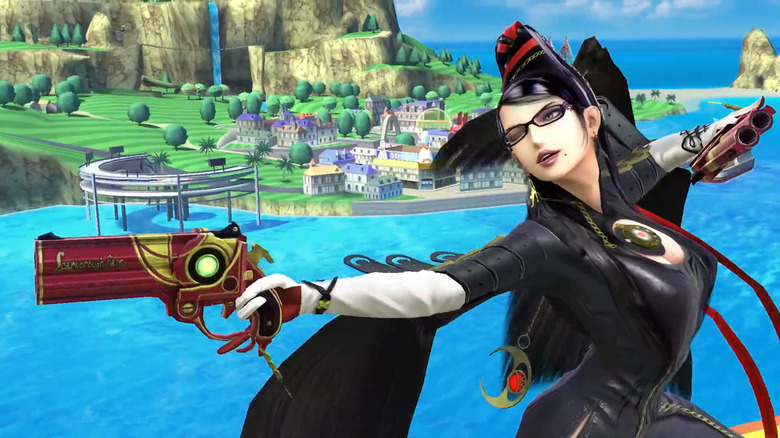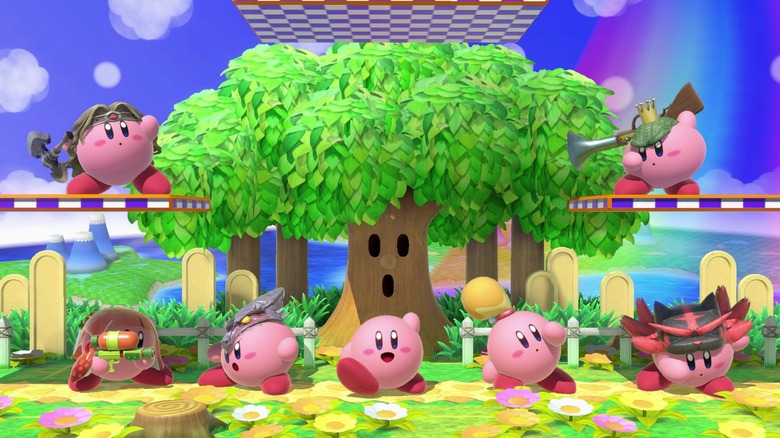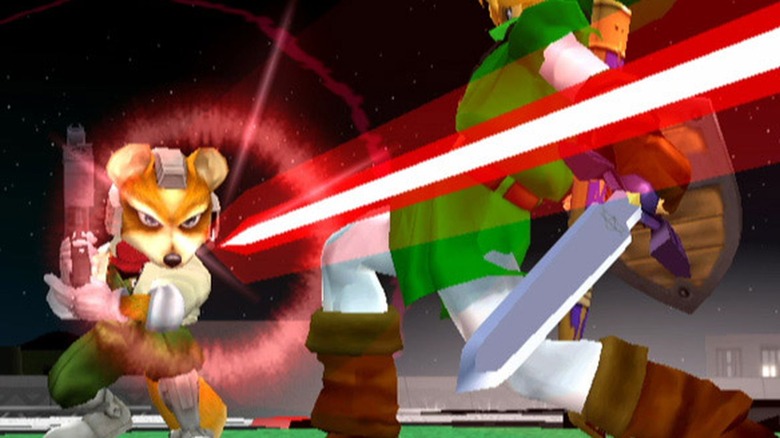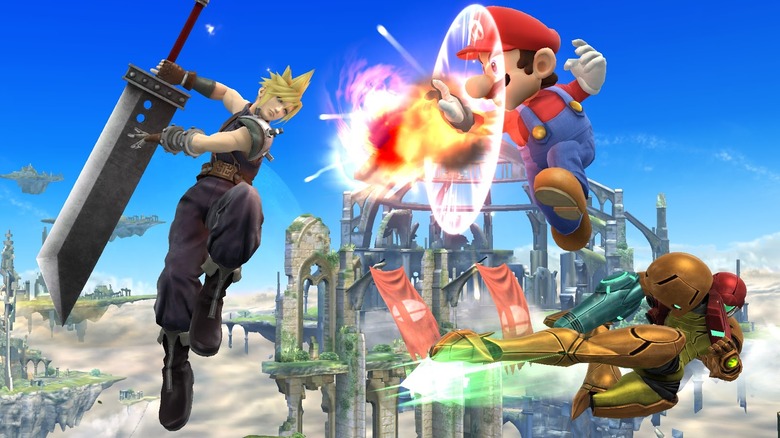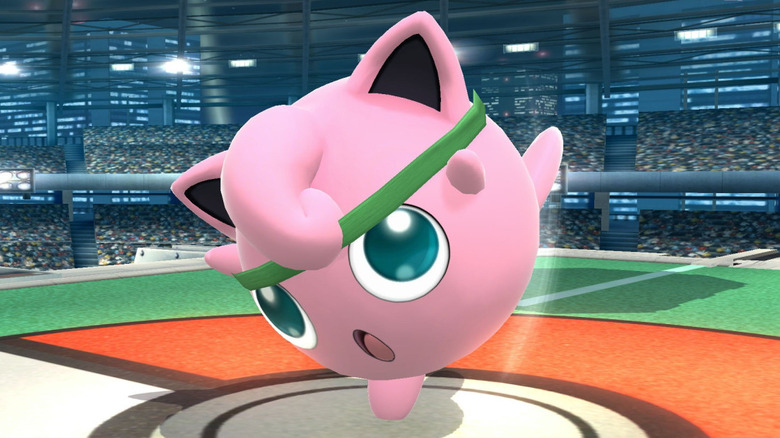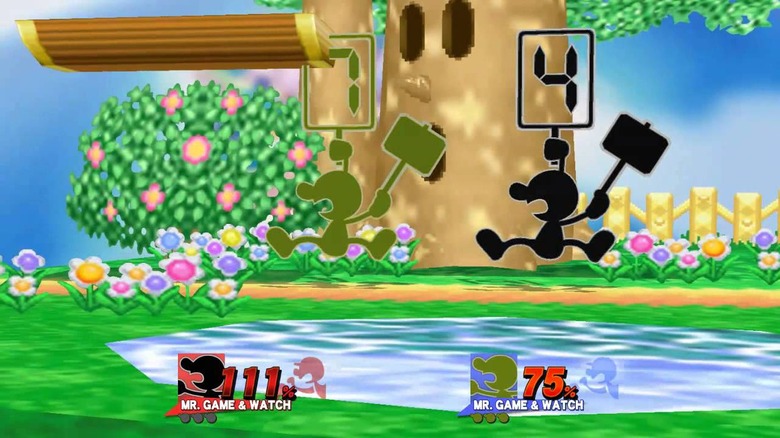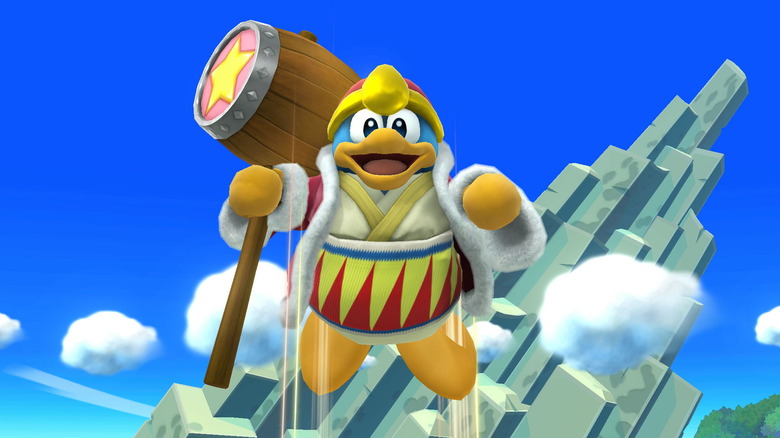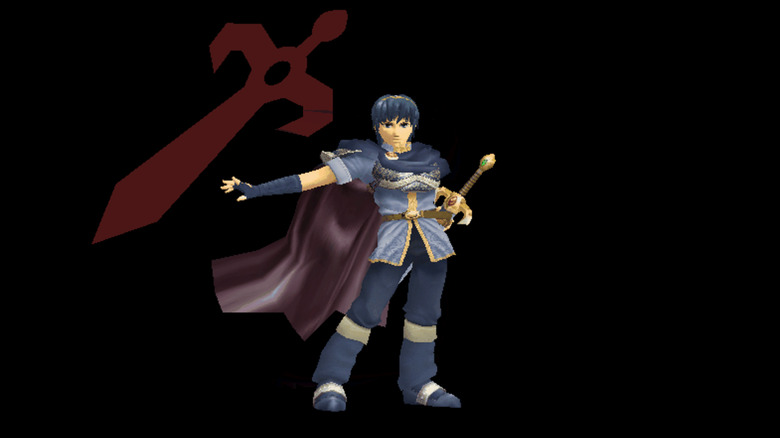The Cheapest Characters In Smash Bros.
The fighting genre typifies the kind of diversity that appeals to hardcore and casual gamers alike. While games like Super Smash Bros. Ultimate occupy the far end of the spectrum when it comes to roster variance, any fighting game worth its salt has a wide range of characters and styles. When a newer player begins to find the moves they enjoy most, a well-designed fighting game has a character at the ready to become their main.
Balancing that kind of variety is hard, though, making the occasional controversy inevitable. For a franchise with as massive a roster Super Smash Bros., balancing is something that has to be done over time. It's impossible to get it right prior to launch, and series creator Masahiro Sakurai knows it. Because of that, Sakurai tends to lean toward creating powerful, experimental characters, and that had led to some frustrating fighters. Here's our run-down of the cheapest characters in Super Smash Bros. history.
Meta Knight (Super Smash Bros. Brawl)
If fans really wanted to make the argument that Masahiro Sakurai plays favorites in character balancing, Meta Knight is where they would start. Meta Knight is a member of the Kirby universe, which was created by Sakurai and has long been part of a running joke that states he favors these characters over other fighters. The Meta Knight that debuted in Super Smash Bros. Brawl was on a power level few characters had ever flirted with in the series prior to him.
What made Meta Knight extremely frustrating, especially for competitive players, was something called "transcendent priority." In-game, it's a part of the complex algorithm that determines moves being cancelled out, who hits who, and more. Transcendent priority is too complex to sum up here, but it basically boils down to moves that can't be cancelled out by other hitboxes. This makes them very difficult to deal with.
Almost all of Meta Knight's moveset in Brawl had transcendent priority. It was absurd, and coupled with his insane recovery rates and top-tier edgeguarding, he became a pain to play against. Meta Knight is one of the few characters to ever achieve "SS" tier in any Super Smash Bros. title, and he had to be banned from competitive tournaments so that other characters had a chance. If that isn't cheap, we don't know what is.
Ice Climbers (Super Smash Bros. Melee)
The Ice Climbers are an example of a fighter that does one thing and does it very well. Nana and Popo don't really set the world on fire when measured by traditional metrics of play, and most of their moveset is too gimmicky to work at the top levels of competition. The key word there is most, though. The Ice Climbers were at their casual best in Super Smash Bros. Melee, and it was because of one concept that would come to terrorize those who played against them: wobbling.
Wobbling is an infinite combo that was exclusive to the Ice Climbers, and was performed in a way that made it impossible to break out of Popo's grab while an opponent was continuously hit by Nana. The technique could also be performed on every roster member except another Ice Climbers player. Wobbling was performed by desyncing the Ice Climbers, which then allows them to act differently, as described in the technique.
Wobbling is one of the most frustrating mechanics that ever existed within the series because once it's happening, there's no way to break out of it. Because of the Ice Climbers' other flaws, they never achieved the kind of tournament success one might expect from a mechanic that powerful. Still, if a friend ever busted this out during a party, there was a decent chance they'd be looking for new friends by the end of the night.
Pikachu (Super Smash Bros. Ultimate)
Pikachu has always flirted with Super Smash Bros. relevance. The Pokémon franchise mascot has been around since the game's debut on Nintendo 64 and has rarely risen above mid-to-high tier levels in competitive play. Pikachu's iteration in Super Smash Bros. Ultimate, however, has made it a much more frustrating opponent than prior versions.
The changes made to the Super Smash Bros. Ultimate game engine have been praised for creating a game with a faster pace. While that makes it more appealing to watch, it also makes traditionally quick characters like Pikachu all the more dangerous. Pikachu was also given a tremendous amount of buffs prior to Ultimate's release, including significantly more damage from ground attacks and less aerial landing leg.
The result has been a lightning-quick Pikachu that can dash around the map while dealing big chunks of damage when it lands an attack. Pikachu also retained its omnipresent down+B thunderbolt attack that has been the bane of many air-based characters' existence for generations of Smash. That combination made the yellow rodent an absolute menace in Super Smash Bros. Ultimate's early days.
Inkling (Super Smash Bros. Ultimate)
Inkling was the front-runner for a character that might be too good in the early going of Super Smash Bros. Ultimate. Historically, characters that are new to the series are the first to be labelled as problematic simply because they are unfamiliar to the community. That was likely the case with Inkling, who doesn't really possess any of the qualities that make a character broken.
What Inkling does have, though, is one of the fullest, most reliable kits in the entire game. Inkling has strong options for offense, defense, edgeguarding, ledge trapping, and recovery, to name a few of the more important evaluation categories for competitive Smash viability. The only thing holding Inkling back is a lack of range, but that's a common flaw in most Smash characters and simply prevents Inkling from being oppressive.
So what's cheap about Inkling? The character is simply annoyingly consistent. With no weaknesses and a feel bad attack in the paint roller stun, playing against Inkling can simply be a miserable experience. The character also possesses a relatively easy learning curve, meaning that Inkling showed up early and often in the Super Smash Bros. Ultimate online multiplayer experience.
Bayonetta (Super Smash Bros. 4)
Bayonetta might be the cheapest character in the history of the franchise, giving Meta Knight a run for his money. Bayonetta debuted in Super Smash Bros. 4 as a DLC character, and just days after she appeared players began to express concerns over her moveset, which many felt was exploitable and waiting to be broken.
Those players were right, and breaking Bayonetta didn't take long. With just a few hours of practice, players could execute a zero-to-death combo with Bayonetta that, while preventable, could realistically only be blocked by some of the better players in the world. That combo chain also made Bayonetta invulnerable during its execution, for a bit of added salt in the wound.
Part of what made Bayonetta feel cheap was that she was also a DLC character, meaning that fans had to pay $5.99 to unlock her. Having to pay extra money for the ability to play what was the undisputed best character in the game at the time of her release made Super Smash Bros. 4 feel like it had just introduced a pay-to-win mechanic.
Eventually, Bayonetta had to be nerfed as the Super Smash Bros. 4 community began to reach a breaking point. Post-nerf, she was still considered by many to be too strong, with fans asking her to be banned or nerfed again up until the release of Super Smash Bros. Ultimate in 2018 — a testament to how cheap Bayonetta truly was.
Kirby (Super Smash Bros. 64)
There's a reason that Kirby has remained a bottom-to-mid tier fighter for most of Super Smash Bros. history. Kirby was actually one of the best fighters in Super Smash Bros. 64, so much so that he had to be significantly nerfed prior to Melee.
The Pink Nightmare is the favorite creation of series creator Masahiro Sakurai, which probably influenced how the designer approached the character's moveset in the first iteration of Smash Bros. In Super Smash Bros. 64, Kirby had a huge hit box on most of his moves, which made it easy to clip characters who appeared to be just out of range. Kirby also had a relatively quick movement speed, especially compared to his later versions.
The cheapest thing about Kirby was his smash attack. It was, quite simply, overpowered, being capable of KO'ing an opponent who was as healthy as 80% damage. Sure, it's easy being one of the best characters on the smallest roster Super Smash Bros. has ever had, but Kirby was the cheapest, too — a trait he has dropped since.
Fox (Super Smash Bros. Melee)
The Super Smash Bros. Melee version of Fox is the poster child for a cheap fighting game character. Not only was Fox the consensus best character in the game, he was also the very first "SS" tier fighter in Super Smash Bros. history, representing the clear leap from a varied top tier to a "play this character or lose" environment.
Fox was emblematic of Super Smash Bros. Melee's issues with speed balancing, outstripping almost every opponent with his move speed. That made him exceptionally good at controlling the map and, in the hands of a skilled player, made him extremely difficult to contain.
The biggest problem with Fox, though, was Reflector. Reflector was the fastest move in the game with a minimal frame startup and could still be jump cancelled. That made for an unheard of level of versatility, allowing Fox characters to see how their opponents reacted before making the call on committing to an attack or backing off.
Those qualities made Fox incredibly frustrating to play against. The long-running and bitter joke within the Melee community was that there was at least one character capable of competing with Fox: Falco, his clone fighter, whose small tweaks to his design still made him a solid tier below Fox.
Cloud (Super Smash Bros. 4)
Bayonetta might have been a huge problem for Super Smash Bros. 4 in her own right, but she wasn't the only one fans were annoyed with. Final Fantasy 7's Cloud was also a completely busted fighter who came via DLC, kicking off fan debate about whether or not Nintendo was making a grab for money with the game's add-on fighters.
Cloud's Buster Sword made him abysmal to fight against. It gave him some of the longest reach the series has ever seen and some of the most bizarre, disjointed hitboxes in Super Smash Bros. history. Cloud's limit break meter was also something that opponents needed to keep track of, but was only noticeable through on-screen cues, putting the onus on Cloud's opponents to add an extra element to their game. It's an unfair demand, and Super Smash Bros. Ultimate has since rectified that by nerfing Cloud's limit break.
Ultimately, it was Cloud's reach that made him so frustrating and cheap. It also made him more annoying in casual play – trying to explain to a friend why they're still getting hit by a character's attacks even when it looked like they dodged was the source of a lot of discontent in multiplayer SSB 4 settings.
Jigglypuff (Super Smash Bros. Melee)
Jigglypuff wasn't even in the top tier of Melee, but that didn't stop the Pokémon from cementing its status as one of the cheapest fighters in the history of the franchise. The reason? The Wall of Pain technique, an exclusive to Jigglypuff in Melee and one of the best edgeguarding techniques ever implemented.
Jigglypuff could basically float to make sure it followed its opponent's trajectory off the edge of the map and use repeated back aerials to push them all the way across the screen. Because Jigglypuff had excellent recovery and mobility, it was extremely hard to move in a way that broke up the [Wall of Pain], and we soon had a technique that could end friendships.
Wall of Pain has since evolved to become a term that refers to this technique being implemented by any fighter, and since Jigglypuff, other nuisances like Bayonetta have had access to [Wall of Pain] as well. It's a calling card for cheapness in Super Smash Bros., and we can't in good conscience recommend busting this one out on the people you love.
Mr. Game & Watch (Super Smash Bros. Brawl)
Mr. Game & Watch enjoyed his best success when he was on the Super Smash Bros. Brawl roster, existing as a high-mid-tier fighter that even saw some serious competitive play from time to time. In that context, he was never really feared, nor was he the subject of a campaign to get him banned from tournament play.
The thing about Mr. Game & Watch, though, is that his Judge ability basically shouldn't exist. It adds an inherent amount of randomness to any game he's present in, and can change the tone of a match in an instant. Imagine a great battle between two competitors ending in a flash because the Mr. Game & Watch player got trigger-happy, went for Judge, and hit a 9.
Judge randomly displays a number on the hammer Mr. Game & Watch swings during its move execution, producing a random effect determined by the number that shows up. A 1 actually damages the Mr. Game & Watch player, while 9, the highest number, is almost always an instant KO. A 9 from Judge can even KO players at around 15% damage, which is an absurd statistic.
Mr. Game & Watch is cheap because things can be going so right against him only to see a stock evaporate out of nowhere because he high rolled a Judge attack on you. That's never a fun experience.
King Dedede (Super Smash Bros. Brawl)
Stop us if you've heard this one before — Sakurai loves his own characters. King Dedede is another entry from the Kirby universe, which means he has enjoyed at least some notoriety as a strong competitor with an overpowered move.
King Dedede's Super Smash Bros. Brawl incarnation possessed one of the most notorious down throws in the history of the franchise. It's one of the more potent chain attacks the series has ever seen, and it can go infinite against nearly two-thirds of Brawl's roster if they're pinned against a wall. Some characters, unluckily enough for them, don't even need to be near a wall to have Dedede go infinite against them. "Going infinite" in this case means dealing as much damage as the Dedede player would like before careening a player off screen to their demise.
King Dedede was also pretty hard to KO in his Brawl iteration, as is the tradition for larger characters. This combination of traits made Dedede feel incredibly cheap to play against, especially for players who are just learning the competitive ropes of Brawl while still unfamiliar with each character's more nuanced movesets.
Marth (Super Smash Bros. Melee)
Marth was a solid all-arounder in Super Smash Bros. Melee who really wouldn't have made this list had he not also been the progenitor of the Ken Combo. The Ken Combo was a series of moves developed by a professional Marth player named, well, Ken, and while it wasn't broken by any means, it sure felt like it when it happened to you.
The Ken Combo would see players execute a progression of neutral aerials, forward aerials, and a down spike that would juggle a character off the edge of the map and then send them hurtling toward their doom. The thing about the combo was that it wasn't actually that easy to pull off – many players would attempt it in tournaments and miss, and it required a level of precision that didn't usually exist in casual household matches.
That said, it still felt incredibly cheap to watch. The combo had very little play to it once it was in progress, and getting caught in a Ken Combo could make an exciting match suddenly end on the spot. Marth in Melee isn't anywhere near the most egregious of Super Smash Bros. cheap characters, but he deserves a spot on the roster of the cheapest thanks to the existence of Ken Combo.

